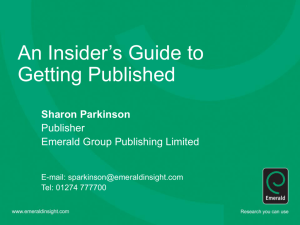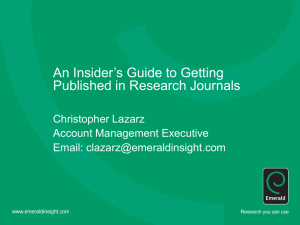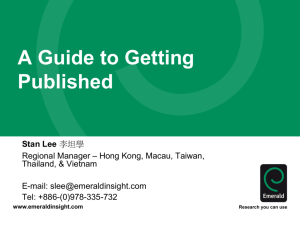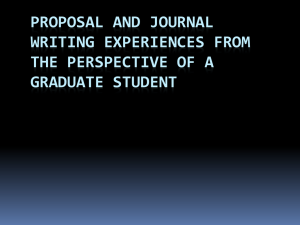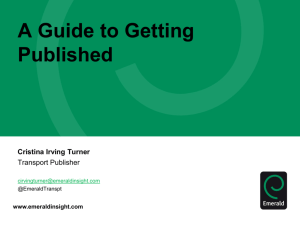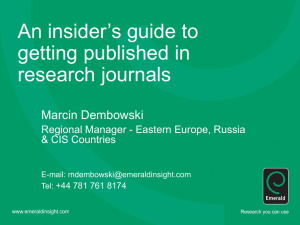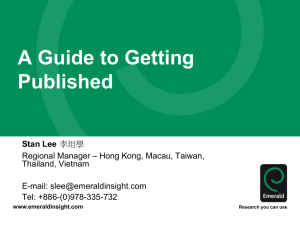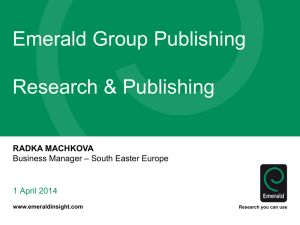Structuring Your Paper - Emerald Group Publishing
advertisement
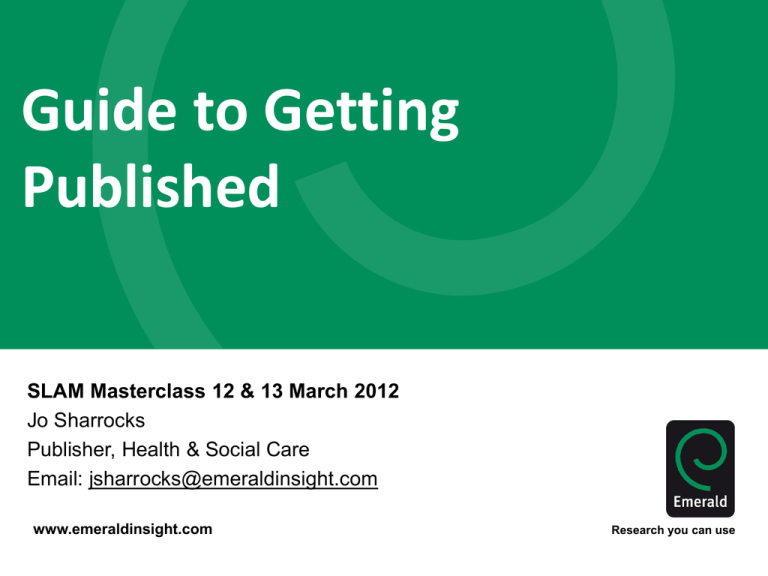
Guide to Getting Published SLAM Masterclass 12 & 13 March 2012 Jo Sharrocks Publisher, Health & Social Care Email: jsharrocks@emeraldinsight.com www.emeraldinsight.com Research you can use Aims of the session • A brief introduction to Emerald and our journals • Why publish in journals? • To encourage you to share your knowledge, i.e. to get you writing • To ‘demystify’ the publishing process • Additional tips, insider knowledge and the answers to key questions to maximize your chances of publication including: – Tips on how to structure your paper – How to deal with reviews and revisions of your paper A brief introduction to Emerald Company history • Emerald Group Publishing Limited • Founded in 1967 in Bradford, West Yorkshire • Three core markets: Public, Corporate, Academic • 250+ journals, 240+ book series, 300 stand-alone texts • Over 21 million Emerald articles were downloaded in 2010 – more than 50,000 a day! • Emerald’s journal usage has grown by 15% every year in the last 3 years (2008-2010) Potential readership of 15 million A brief introduction to Emerald Health and Social Care Collection • Acquisition of Pier Professional (2011) • Creation of Health and Social Care Collection • Sub collection of Learning/Intellectual Disability titles • Content delivers high-quality, up-to-date, peer-reviewed research and evidence-based practice with the overall aim of considering social impact and improving practice. Why publish in journals? Take an idea Publish it Reach an audience Why publish in journals? Being published means: • Your paper is permanent – enters the ‘body of knowledge’ for your subject area • Your paper appears in both the print and electronic versions of the journal • Your paper is improved by suggestions from reviewers and/or the editor via the review process • Your paper is actively promoted by the publisher – reaching a large audience • Your submission is trustworthy – material that has been published carries a QA stamp Why publish in journals? What’s in it for me? • Work in print – name in print • Share your ideas – develop your career • Prove success – support/influence future decisions • Demonstrate your knowledge – gain external recognition • Highlight new initiatives – gain internal recognition Why publish in journals? What do previous authors say? Career 80% of our authors published with a view to career progression and personal development Subject Development 70% wanted to share knowledge and experience Altruism 85% published for esteem and receive internal and external recognition Own Business 50% published for company recognition and to promote their business Recent testimonial (published paper in Health & Social Care title) “I just wanted to let you know that your advice paid off - Thank you! As a result of publishing my paper I won an Award (£2,500) that has enabled me to produce marketing and promotional materials, hire meeting rooms and generally kick start the organization under its own constitution.” How to get started? What do I write about? • Have you completed a project that concluded successfully? • Are you wrestling with a problem with no clear solution? • Do you have an opinion or observation on a subject? • Have you given a presentation, briefing or conference paper? • Are you working on a Doctoral or Master’s thesis? • Do you have a new idea or initiative? If so, you have the basis for a publishable paper How to select the right journal? • Choosing a journal to publish in is an investment decision. A good choice can enhance the impact of your work and your reputation • Factors to consider are relevant readership, recent articles, most communicative, societies and internationality, likelihood of acceptance, circulation, time from submission to publication • What type of paper are you planning to write i.e. practice paper, research paper, case study, review, viewpoint? Check first what type of paper the journal accepts. • Are rankings important to you? Thomson Reuters ISI is the most well known ranking, but others exist. Citations are a good, but not complete, guide to quality • Usage is a better measure of utility • Be political (e.g. national vs international) and strategic (e.g. five articles in ‘low ranked’ journals vs one in ‘top ranked’ journal) How to select the right journal Target to avoid desk reject! “Many papers are rejected simply because they don’t fulfil journal requirements. They don’t even go into the review process.” • • • • • • Identify a few possible target journals/series but be realistic Follow the Author Guidelines – scope, type of paper, word length, references style, etc Find out where to send your paper (editor, online submission e.g. Scholar One). Check author guidelines which can be found in a copy of the journal/series or the publisher’s web site Send an outline or abstract and ask if this looks suitable and interesting (or how it could be made so) Read at least one issue of the publication – visit your library for access Include a cover letter – opportunity to speak directly to the editor, convince them of the importance of your paper to the journal Maximising your chances of success Author guidelines Every journal has detailed notes and guidelines Maximizing your chances of success Understand the journal supply chain Author Quality papers (research and practice) Editor EAB and reviewers Solicits new papers Research Handles review process Promotes journal to peers Publisher/ Managing Editor The link between the publishing company and editor Production QA – sub-editing and proof reading Access via library Convert to SGML for online databases Hard copy Helps editors succeed in their role and build a first class journal Print production Overall responsibility Despatch for journal Attends conferences Promotion and marketing Develops new areas of coverage Attends conferences Handles production issues Users Added value from publisher Database Third party Structuring Your Paper www.emeraldinsight.com Research you can use Standard journal article structure • • • • • • • Abstract (structured format for submission to Emerald titles) Introduction Literature Review Research methodology/approach Findings Discussion Conclusion Structuring Your Paper: What is the Purpose of the Paper? • Purpose Statements – What is the significance of the paper? – Why is it important and original? – Who will be interested, who is the intended audience? – What next: what are the implications for practice, what are the further research questions • Purpose Statements - should also be central to the article’s composition. It will help you develop the structure, and provide a focus. • Thesis Statements – a statement of purpose that does not merely state coverage but which also sets out an argument. Structuring Your Paper: Abstracts The abstract helps ‘sell’ your article Editors: are busy! The abstract is their first contact with your paper and can sometimes make a decision at that point whether or not it is suitable for their journal. Readers (online): The abstract is often all a reader will see until they pay for the article. Might not go further if the abstract doesn’t tell them clearly what the paper is about. A good abstract might make them want to read the full-text article. Always ensure that you are clear, honest, concise and have covered all the major points. Structuring Your Paper: The Introduction • What is the importance of the introduction? • It provides context and set out the paper's main aims: – Why the topic is important, what it contributes to the body of knowledge, background to the research, what the structure of the paper will be, what made you decide to research this topic/write the article? • How long should the introduction be? – The introduction should be long enough to develop the purpose statement and set out the background to the topic: - It should not overwhelm or be out of proportion to the rest of the paper • When should the introduction be written? • It is probably wise to write the introduction first. • - But always revisit it as you write. Structuring Your Paper: The Body of the Paper • The Body of the Paper – Literature review – Research methodology or approach – Findings • Literature review – Quote those papers from which your own research follows – Make it clear what the position was prior to your own paper, and how your paper adds to it – Make sure that the citations are up to date – Cite only your own articles in so far as they are directly relevant to your research/approach – Any work that is not your own MUST be referenced Structuring Your Paper: The Body of the Paper • • Research methodology or approach – Indicate the main methods used – Demonstrate that the methodology is robust, and appropriate to the objectives – Focus on telling the specifics Findings – Significant facts – Research narrative Structuring Your Paper: Writing the Conclusion Writing the Conclusion • Do… – Summarize and conclude, restating the main argument, and presenting key conclusions and recommendations – Say to what extent your original questions have been answered – State how your findings/new framework, etc. apply to theory and to the world of practice – State the limitations of your research – State what are the implications for further research – Don't… – Start a new topic or introduce new material – Make obvious statements – Contradict anything you said earlier How to increase electronic dissemination • Use a short descriptive title containing main keyword – don’t mislead • Write a clear and descriptive abstract containing the main keywords and following any instructions as to content and length • Provide relevant and known keywords – not obscure new jargon • Make your references complete and correct – vital for reference linking and citation indices • All of this will make your paper more discoverable which means more dissemination and possibly more citation Maximising your Chances of Success What makes a good paper? HINT: Editors and reviewers look for … • Originality – what’s new about subject, treatment or results? • Relevance to and extension of existing knowledge • Research methodology – are conclusions valid and objective? • Evidence based • Clear implications for practice. (the ‘so what?’ factors!) • Clarity, structure and quality of writing – does it communicate well? • Sound, logical progression of argument • Theoretical and practical implications • Recency and relevance of references • Internationality/Global focus • Adherence to the editorial scope and objectives of the journal • A good title, keywords and a well written abstract Reviews and Revision www.emeraldinsight.com Research you can use The Review and Revision Process Timetable • There are many different forms of review: Editor Review, Open Review, Double Blind Peer Review. • The Editor(s) do an initial read to determine if the subject matter and research approach is appropriate for the journal (approx. 1 week) • The Editor(s) identify and contact two reviewers (approx. 1 week) • Reviewers usually have 6-8 weeks to complete their reviews • The Editor(s) assess the reviewers' comments recommendations and make a decision (approx. 2 weeks) and • Expected time from submission to review feedback: 3-3.5 months The Review and Revision Process Receiving feedback • • • • A request for revision is good news! It really is You are now in the publishing cycle. Nearly every published paper is revised at least once Don’t panic! Even if the comments are sharp or discouraging, they aren’t personal • • If your paper is rejected: Don’t give up! Everybody has been rejected at least once Ask why, and listen carefully! Most editors will give detailed comments about a rejected paper. Take a deep breath, and listen to what is being said Try again! Try to improve the paper, and re-submit elsewhere. Do your homework and target your paper as closely as possible Keep trying! • • • Process of acceptance for a journal – just one example The Review and Revision Process How to revise your paper • Acknowledge the editor and set a revision deadline • Clarify understanding if in doubt – ‘This is what I understand the comments to mean…’ • Consult with colleagues or co-authors and tend to the points as requested • Meet the revision deadline • Attach a covering letter which identifies, point by point, how revision requests have been met (or if not, why not) The Review and Revision Processs Example – agreeing with the reviewers comments • Dear Editor, • Let us open by thanking the two reviewers for their insightful comments. They gave us clear guidance and some positive critiques. Following their suggestions, we spent more time reading and came to the revision process better prepared. We enjoyed the process and think that the reviewers’ comments have tremendously affected the revised draft. Both reviewers should now clearly see the difference they made to the revised manuscript. In the following lines we detail the changes in line with the reviewers’ comments. Reviewer: 1 Again, we would like to express our appreciation for your extremely thoughtful suggestions. As you will see below we have been able to revise and improve the paper as a result of your valuable feedback. You highlighted that we did not spend enough time discussing the implications of our arguments for current understandings of Drucker’s work. We agree with your suggestion and have added in two additional paragraphs in the conclusion (p.30-1), and a few comments within the paper (i.e p.11), that are devoted to outlining the implications of our analysis. We have kept our discussion brief to ensure we maintain the commitment to the appropriate page and word length, but what we do outline should make clear what this perspective on Drucker makes relevant for management practitioners and scholars alike. • • • How to promote your work • Why? • Influence policy • Raise your profile • Attract collaborators and funding • New opportunities e.g. in consulting, the media • How? • Use your network e.g. through listservs, press releases or simply link to the article in your email signature • Contact the authors in your reference list • Hone your media skills and ‘brand image’ • Ask the publisher to provide you with book or journal leaflets • See Support and services for authors and Editors on the USB stick Any Questions? For any answers you didn’t get today (or were too shy to ask) … Jo Sharrocks: jsharrocks@emeraldinsight.com Tel: 01274 785141
